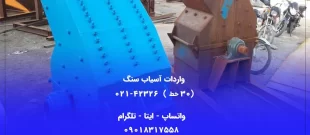قدم به قدم با واردات كالا : آیا فروشنده و تولید كننده كالای مورد نظرتان را در خارج از كشور می شناسید؟ جهت داشتن واردات پرسود و بدون ریسك با مشاورین با تجربه و متخصصین حرفه ای گمرك در ارتباط باشید.
اگر اطلاعات آن را دارید اولین مرحله را طی كردید. در غیر این صورت باید فروشنده آن ابتدا مشخص گردد.
2- استعلام مشخصات فنی و قیمت كالا پس از شناسایی سازنده یا فروشنده
3- دریافت نمونه كالا (توصیه می شود حتما” قبل از انجام واردات تجاری نمونه كالا دریافت و بررسی گردد).
4- تصمیم گیری در رابطه با نوع ، مدل و تعداد كالای وارداتی – كه باتوجه به شرایط فروش در بازار داخلی، قیمت تمام شده كالا – میزان تقاضا – زمان فروش كالا و سایر آیتم های دیگر قابل محاسبه می باشد.
5- دریافت پیش فاكتور ازفروشنده ( پروفرما اینویس ) با شرایط و مفاد دو جانبه و رعایت نكات لازم در آن
6- داشتن اطلاعات كافی از تعرفه گمركی و شرایط واردات كالای مزبور
7- داشتن اطلاعات در مورد هزینه های مرتبط با واردات كالا از ابتدا تا پس از ترخیص جهت محاسبه قیمت تمام شده واقعی كالا و تصمصیم گیری نهایی
8- محاسبه قیمت تمام شده واقعی كالا ( قیمت تمام شده كالا در انبار با احتساب كلیه هزینه های سربار مشمول)
9- دریافت تخفیفات توافق نهایی بر سر قیمت كالا و ترم فروش با فروشنده
10- بررسی تامین بودجه واردات و تصمیم گیری نهایی جهت واردات
11- توافق بر سر شیوه پرداخت مبلغ كالا به فروشنده( ترم پرداخت)
12- توافق در زمان حمل كالا و شیوه حمل. ( ترم تحویل )
13- اطلاع دقیق از مجوزها و استانداردهای لازم برای واردات و توافق جهت اجرای استاندارها با فروشنده
14- چك كردن اسناد حمل مورد نیاز با فروشنده و دریافت تائیدیه از او جهت توانایی ارائه اسناد فوق
15- توافق جهت بازرسی كالا (بنا به ضرورت)
16- آیا كارت بازرگانی دارید؟ اگر بله تمامی اسناد شامل پروفرما و سایر اسناد دیگر می تواند به نام شما صادر گردد، ولی اگر كارت بازرگانی ندارید می بایست از افراد باتجربه در امر واردات كمك بگیرید.
17- انجام ثبت سفارش در وزارت بازرگانی قبل از هر گونه پرداخت – متاسفانه برخی تجار كه هنوز به سبك سنتی و غیر تخصصی كار می كنند ثبت سفارش را در آخرین مرحله حتی پس پرداخت كل وجه به فروشنده یا حتی پس از رسیدن كالا به گمركات انجام می دهند(در پرداخت های نقدی T/T) كه این عمل باعث بالا رفتن ریسك واردات میگردد، چراگه با توجه به قوانین شناور ممكن است در هر مقطع زمانی قوانین تغییر كرده و وارد كننده مطلع نباشد و متضرر گردد. ولی چنانچه تاجر قبل از هر اقدامی ثبت سفارش كالا را انجام دهد از بسیاری از مشكلات آتی جلوگیری خواهد نمود.
برای دریافت اطلاعات پیرامون واردات کالا و ترخیصکالا کلیک کنید.
18- دیافت ایران كد و مجوز اولیه استاندارد در صورت شمول
19- دریافت مجوزهای لازم دیگر جهت واردات قبل از ورود كالا از سازمانها و ارگانهای ذیربط
20- انجام پبش پرداخت طی توافق قبلی – چه به صورت T/T یا L/C یا D/P یا سایر ترمها
21- پیگیری و رصد تولید صحیح و به موقع كالا
22- انجام بازرسی قبل از حمل (در صورت لزوم)
23- دریافت نمونه كالا بعد از تولید انبوه و قبل از حمل در صورت ضرورت
24- قدم به قدم با واردات كالا – هماهنگی جهت حمل كالا (در صورت خرید كالا با ترمهایی بجز ترمهایی كه حمل كالا به عهده فروشنده یاشد)
25- كنترل پیش نویس اسناد حمل
26- پرداخت مبلغ بالانس كالا با ترم توافق شده (در روشT/T)
27- دریافت اصل اسناد حمل از فروشنده
28- پیگیری رسیدن كالا به گمركات و دریافت اسناد كشتیرانی و سایر اسناد
29- دریافت اسناد تامین ارز
30- دریافت اسناد بازرسی (در صورت لزوم)
31- دریافت مجوزهای لازم از سازمانهای دیربط كه پس از ورود كالا باید دریافت گردد( باید قبل از انجام واردات مراحل اداری انها را انجام داده باشید).
32- ترانزیت كالا به سایر گمركات در صورت نیاز
33- ارائه مدارك و توضیحات كامل به ترخیص كار جهت انجام امور ترخیص
34- پرداخت حقوق و عوارض گمركی و سایر هزینه های مرتبط با ترخیص كالا
35- حمل كالا به انبار پس از ترخیص
36- انجام تعهدات ارزی (تامین ارز) در صورت وجود و تعهدات مالیاتی ( مالیات واردات) و …





لطفا در مورد این مطلب نظر دهید